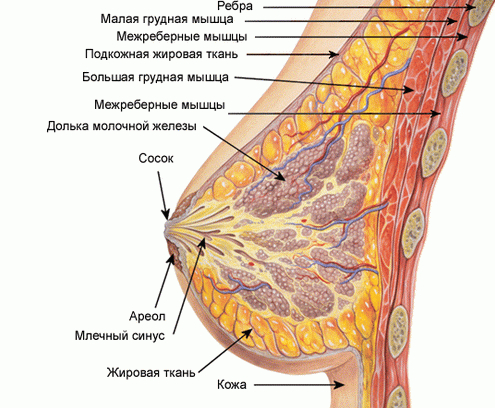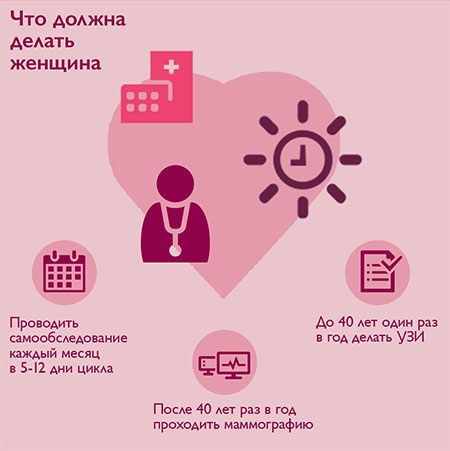The article analyzes the experience of optimizing the diagnosis and surgical treatment of intraductal neoplasms of the mammary gland with the combined use of radiation and endoscopic techniques and compares it with traditional approaches to the diagnosis of this pathology.
The results were evaluated in accordance with international protocols for the management and treatment of patients with breast neoplasms.
Only in our article on estet-portal.com you can get acquainted with the latest research in the field of diagnosis of breast neoplasms.
Object and research methods
158 clinical studies were divided into two groups: in the control group (n = 81) traditional methods of diagnostics and surgical treatment were used: X-ray method of examination and echography, in the main group (n = 77) − methods of selective galactoductography under endoscopic control, stereotaxic trephine biopsy under the control of x-ray ductography, double endoscopically and echographically controlled marking with the establishment of features of the arterial blood supply to the areola of the breast.
Follow us on Instagram!
Images obtained were evaluated according to the guidelines of the Japanese Association of Mammary Ductoscopy. Fluid (saline) collected after endoscopic ductoscopy was subjected to cytological examination (ductal lavage).

Pathological studies (reference method) were performed by light microscopy of preparations stained with hematoxylin, eosin and picrofuxin according to van Gieson. If necessary, immunohistochemical studies were used.
X-ray examinations of the breast
In the structure of clinical studies, frequent cases of X-ray negative breast tumors (81.3%) and, accordingly, their low (19.1-30.8%) diagnostic sensitivity were revealed.
Female breasts after childbirth: how milk is produced
So, the role of X-ray examination of the mammary glands, in terms of both establishing indications / contraindications for surgical intervention, and using their results for guiding trephine biopsies, is minimal, providing for the use of the indicated diagnostic methods for examining the mammary glands in limited tactical significance and such therefore requires additional research methods.
Breast involution: diagnosis or condition
Radiocontrast methods of examination of the mammary glands
When comparing the diagnostic efficiency of traditional galactoductography (GDG) and endoscopic mammoplastoscopy of the mammary glands, no significant difference was found in the studied parameters. However, it has been established that GDH has certain advantages in preoperative pathohistological verification, since after traditional or selective contrasting of the secernating ducts of the mammary glands and the identification of specific ductographic signs of breast neoplasms − "amputation" lines or filling defects, conditions arise for performing a stereotaxic trephine biopsy with the developed method.
Thus, it follows that in the absence of endoscopic or ductographic signs of breast neoplasms in patients aged.
At the same time, due to the increased (by 2.5-5.0 times) probability of breast cancer in patients in the pre- and menopausal period with negative results of both first-line diagnostic methods (X-ray examination of the mammary glands / echography) and additional diagnostic methods (galactoductography / endoscopic mammodoscopy), surgery - open biopsy should be offered.
To facilitate the intraoperative search for small-sized breast tumors, their adequate removal with a minimum amount of adjacent tissues, and the prevention of ischemic-necrotic complications from the areolar-papillary complex (ASC) of the breast, it is advisable to use double preoperative marking of tumors inside the breast ducts under endoscopic and EG control, taking into account the peculiarities of the arterial blood supply of ASA.

When using this method, less traumatic surgical interventions are performed more often (by 91.0%) - selective ductectomy, the volume of removed tissues decreases, it helps to reduce the frequency of postoperative complications, and shorten the duration of hospitalization.
Also, as evidenced by the results of histopathological studies, the use of this method contributes to a more reasoned establishment of indications for surgical intervention.
Thus, in 61.7% of patients in the control group, pathological diagnoses were presented with fibroadenomatosis, ductectasia and inflammation, that is, pathological conditions that are not neoplasms of the mammary gland and whose causal role in pathological discharge from the nipple (PVS) is doubtful. On the contrary, in patients of the main group, the diagnoses were not observed.
Breast Cancer Awareness Month at estet-portal.com
It is significant that in women of the main group, after double preoperative endoscopically and echographically controlled marking of intraductal neoplasms of the mammary gland, taking into account the individual characteristics of the arterial blood supply of ASC, solitary or multiple papillomas prevailed (90.9%), which are the real cause of PVS and really need in surgical treatment.
To establish the optimal sequence for the combined use of the developed techniques in combination with traditional approaches, it consists in the use of endoscopic mammodoscopy - the only technique for today that provides direct visual contact with breast neoplasms, as well as avoiding such expensive technologies as magnetic resonance imaging .
Photodynamic therapy in the treatment of breast cancer
Use of traditional and established research methods
The proposed algorithm provides optimal structuring of diagnostic and therapeutic measures in patients with intraductal neoplasms of the mammary gland, excludes the possibility of unreasonable appointment of unnecessary, duplicating studies, objectively establishing indications for surgical intervention, and avoids unnecessary operations.
It has been shown that the consistent combined use of known and developed techniques in accordance with the presented algorithm provides a significant (from 97.5 to 6.5%) reduction in the segment of more traumatic surgical interventions − central ductectomies, noticeable (from 41.0 to 34.0 min) reduction in the duration of operations, statistically significant (p < 0.05) (from 45.4 to 23.8 cm3) decrease in the volume of removed tissues, significant (p < 0.05) (from 11.1 to 3.9%) decrease in the frequency of postoperative complications and shortening of hospital stay.
Nodular mastopathy requires a thorough examination by a mammologist







Add a comment